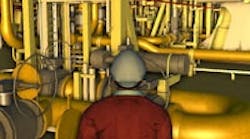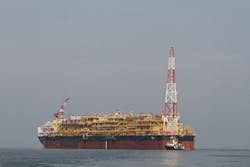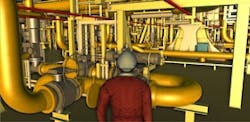Virtual Reality Provides Real Benefits
What if an operator doing rounds on a massive floating production, storage and offloading (FPSO) unit comes upon a visible gas leak and also someone down. To avert a potential crisis, the operator must react quickly and correctly. That’s why oil and gas giant, TOTAL, Paris, is relying on an immersive training simulator (ITS) for operators at two FPSO projects off the coast of Angola, Africa.
“We have to have training that reaches everybody,” notes Nicolas Tarisse, field operations training manager at TOTAL Exploration & Production (E&P).
The simulator provides an accurate 3D immersive environment where a worker can visualize tasks to perform as well as assess and rehearse ways to conduct certain workflows that involve any number of scenarios. TOTAL turned to Siemens Industry for the ITS, which uses its COMOS Walk inside technology.
The ITS enables training to begin before the real plant is in operation. The ITS provides an easy, fast and game-like navigation already familiar to many younger workers, as they have grown up playing video games. An Xbox controller can even be used to provide easy, familiar navigation.
TOTAL does have different types of training for workers but the ITS puts staff in a true 3D virtual environment that effectively teaches them what to do and when to do it. This makes personnel more productive and aware of safety procedures as quickly as possible to maximize profitability.
Figure 1. Located about 100 miles offshore of Angola, the installation has a processing capacity of 220,000 bbl/d.
Figure 2. An avatar can walk through the FPSO unit and encounter situations that raise operational and safety issues.
BROADER APPLICATION BECKONS
ITS technology promises to play a wider role. “The model has a life of its own where it can extend to real-time management, ongoing training, maintenance supervision and execution,” says Marc de Buyl of Siemens.
“We can have our walking avatars in the model. Those can represent the physical presence of the operators monitored through RFIDs, so the control room can know where people are and remotely see whether they are doing what they are supposed to be doing — positioning and execution. And when there are ambiguities and doubts, verbal communication can take place between the control room, experts and the people in the field, all of whom are looking at the same information on a tablet.”
MELISSA TOMPKINS is marketing specialist for COMOS Plant Engineering Software for Siemens AG, Alpharetta, Ga. MANUEL KELDENICH is product marketing manager for COMOS Walkinside for Siemens AG, Alpharetta, Ga.. E-mail them at [email protected] and [email protected].



